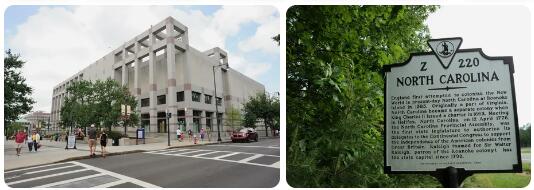Introduction
North Carolina (abbr.: NC or N. Car.), state of the United States of America, 133,783 km2, with 6.6 million inhabitants; capital city: Raleigh.
Physical Geography
Numerous deep inlets line the state’s coastline; in front of it are vast lagoons. To the northeast is the Great Dismal Swamp, which extends into Virginia; this swamp area has been partially drained. Behind the coastal plain stretches the Piedmont Plateau, an undulating area from 60 to 500 m above sea level. The western part of the state consists of a mountain landscape (Blue Ridge Mountains, Great Smoky Mountains, both part of the Appalachians), which increases in height towards the border with Tennessee. Mount Mitchell (2037 m) is not only the highest point in North Carolina, but in the entire eastern United States. Most rivers flow into the Atlantic Ocean; some rivers that originate in the Blue Ridge Mountains belong to the Mississippi River Basin. Eastern North Carolina has a maritime climate; in the southeast even of the subtropical type. A continental climate, but without the excessive temperature differences of the midwestern United States, prevails in the west. Most precipitation falls in the west, on the eastern slopes of the Appalachians. Subtropical storms occur in the coastal area.
Population
The average population density is 48 inhabitants. per km2. About 50% of the population lives in urban areas. The largest cities are: Charlotte, Greensboro, Raleigh and Winston-Salem.
Economy
In North Carolina, traditionally an agricultural state, industry developed strongly after 1945. The main industrial products are textile products and cigarettes. In addition to food, wood processing, chemical and electronics industries. Tobacco is by far the most important agricultural product (North Carolina produces 40% of all tobacco in the United States). Livestock farming (pigs, poultry, dairy products) also occupies an important place. Finally, there are forestry (timber, wood pulp, paper, plywood) and mining (stone, sand, gravel, phosphate, mica). In recent decades, government institutions, trade and financial services have also become increasingly important for the economy. In addition, numerous research and development institutes have established themselves, especially
Sights
The main recreational areas are the beaches and mountain areas, including the Great Smoky Mountains National Park (partly in Tennessee). Besides this and the Cape Lookout and Cape Hatteras National Seashores, the state has several so-called State Parks and protected forest areas. Of historical interest are Fort Raleigh on Roanoke Island, the first English settlement in North America, the Wright Brothers National Memorial at Kitty Hawk and several sites reminiscent of the Liberation War and the Civil War.
Carl Sandburg Home National Historic Site
Carl Sandburg, who lived between 1878 and 1967, was a famous American writer and editor who became famous especially for his poetry. He won two Pulitzer Prizes in his lifetime – one for his poetry and the other for his biography of Abraham Lincoln.
Sandburg was born in Galesburg, Illinois, of Swedish ancestry. Originally a farmer and bricklayer, he later attended Lombard College in Galesburg and became a hotel clerk in Denver. Sandburg fought in the Spanish-American War with the 6th Illinois Infantry and participated in the invasion of Guánico, Puerto Rico in 1898. He began his literary career as a journalist for the Chicago Daily News. He wrote poetry, history, biographies, novels, children’s literature and film reviews. He was also engaged in collecting ballads and folk folklore. He lived most of his life in the Midwest before moving to North Carolina.
The Carl Sandburg Home National Historic Site is located near Hendersonville in Flat Rock, North Carolina. Here we find Conemara Farms, where the writer spent the last 22 years of his life with his family. In addition to the main residence, this farm has various shelters for animals, is surrounded by extensive forests and is interspersed with hiking trails of moderate terrain. There are two small ponds, gardens full of flowers, orchards, trees and greenery. Visitors to this farm can see the rooms that the writer lived in, as well as the nearby barn and dairy.
From June to mid-August, there are regular live performances with samples of Sandburg’s work, which is presented in an amphitheater located in a vast park. Nowadays, more than 26,000 visitors visit this historical place every year. The monument covers an area of 1.07 km2. There are a total of 32 buildings on this property. Now there are about 15 goats on the farm.
History
The area was already visited in 1524 by Verrazano, in 1540 by Hernan(do) de Soto, but finally colonized by the English. In 1585 Walter Raleigh founded the first English colony in America on Roanoke Island and a second in 1587, both of which failed. But from Virginia, the area was populated from 1622, and in 1629 it received its own charter from King Charles I, after whom the country was named. For a long time the situation remained difficult, mainly because of the wars with the Indians (Tusacarora War, 1711–1713), but extensive immigration of Scots and Germans brought some prosperity in the 18th century. The area took an active part in the American War of Freedom against England and in 1789 was the 12th of the states to create the Union. That same year, North Carolina ceded its western territories; from this the territory (later the state) of Tennessee was formed. In the American Civil War, it sided with the South because of its slavery. It recovered faster than other areas from the effects of the latter war and became one of the most progressive states in the south.
